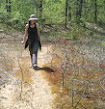
Until I read this book, most of what little soil science and "chemistry" (e.g. over simplified "N-Ph-P" and how-to-alter-your-pH advice) that I had hodge-podged together over the years floated around my mind in scatter-shot unlinked fragments. A lot of it I took more on faith than real understanding, and I also often didn't know what-to-do-1st to start to help heal the problems in my disturbed soils.
Now I know why: most of that soil chemistry is more accurately the processes and products of soil microbiology, and there's nothing mystical or disconnected about it.
I think most of us have been mentally messed-over by the petro-chem hort gardening industries (see the advertisers behind every popular gardening magazine today), but also, a lot of knowledge about soil microbiology is relatively new information too (increased microscopic power in the 90's is what changed this). So while intuitively, we knew that plants, soils and nutrient cycles were more like a super-clever elegant symphony than disparate fields of study, this is the only book that has succeeded in substantiating, factually explaining and pulling-it-all together for me. Which, btw, also means the authors must be really good writers.
If that weren't enough, starting at about page 52 (with a peek ahead at chapter 12), I suddenly started to recognize and then re-interpret dozens of soils / landscapes (old-growth forest -> shittiest dead zones) I've been in, with a new clarity about why (given the criteria of a soil microbiology POV) their plant communities were what they were too! :D That's cool!
There's too much essential and excellent advice in this book to try to sum up, but here's one bone for native plant gardeners: LEAF MULCH. Specifically, dry, brown and aged. Apply it on top of the soil (not into the soil: applying into the soil encourages bacteria more than fungi: which would be fine for annuals and veggies). Why? That mulch will feed and encourage networks of fungi that native plant perennials and woodies NEED to uptake nutrients in at the root level (rhizosphere) below. You can take that on faith or, if you'd rather actually know what's going or to see a lot more excellent advice, read this book! :) It's in circulation at the Toronto Public Library, or buy it. This one's worth it.
31 December 2007
Teaming with Microbes: A Gardener's Guide to the Soil Food Web
Subscribe to:
Post Comments (Atom)


3 comments:
Granuliticly(?) correct but not grammatically correct. Should be teeming not teaming.
donwatcher,
I think they mean "teaming" ...like "swarming (teeming) together to work together (team-ing)"
Greg
I assumed that it was a pun on "teeming" as in "working together with the microbes."
My one big objection to this book was that they didn't mention the invasiveness of earthworms, which are now a huge problem in forests of the Northeastern US. They've depleted the litter layer, which reduces critical habitat for macroinvertebrates and causes erosion problems. There's even some belief that their castings encourage establishment of exotics (which makes sense).
Post a Comment